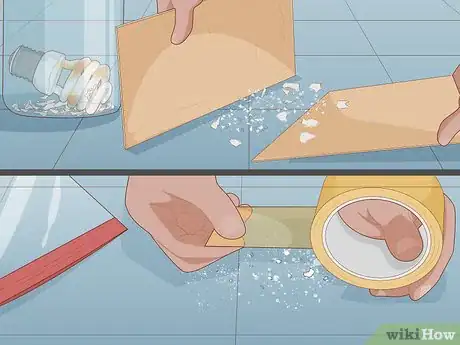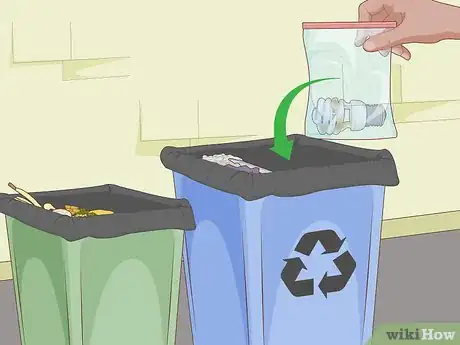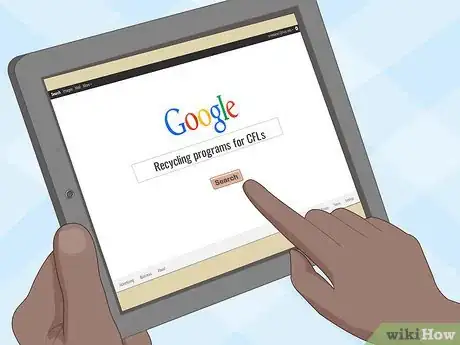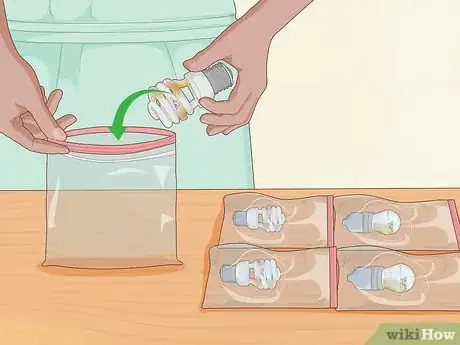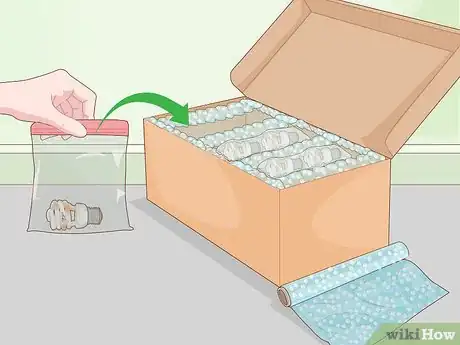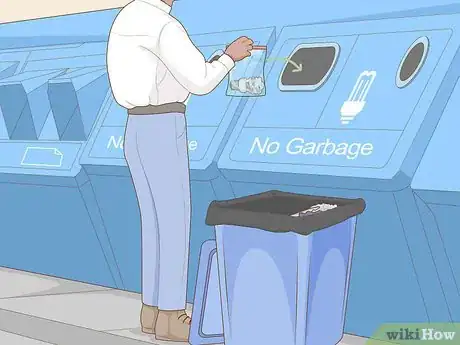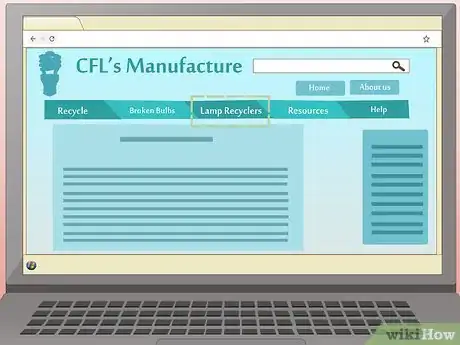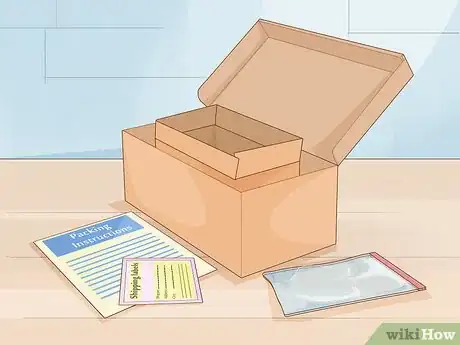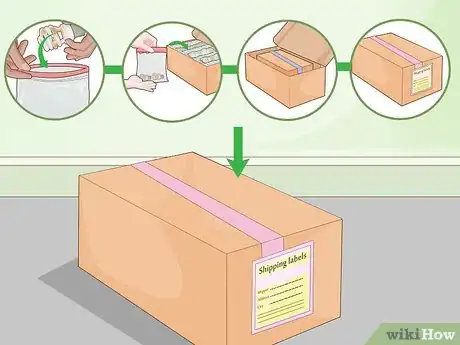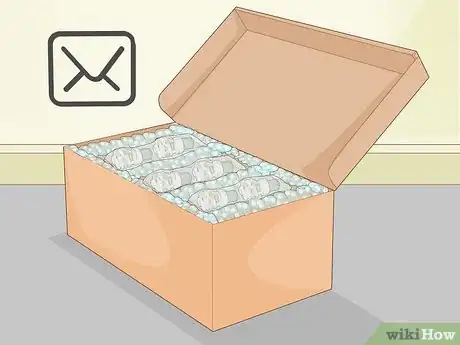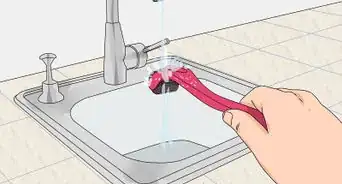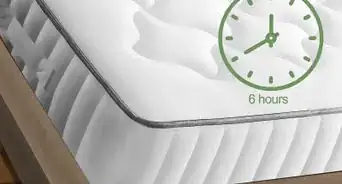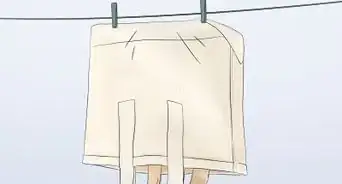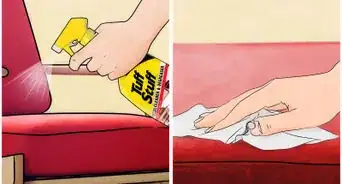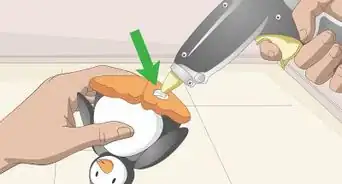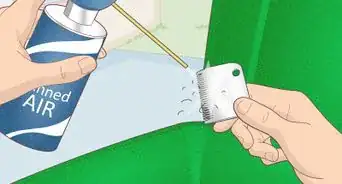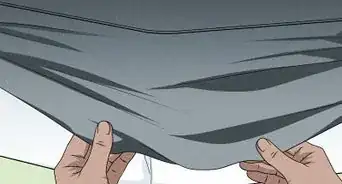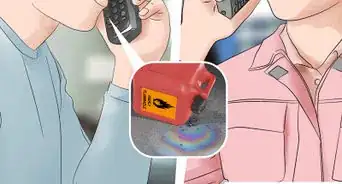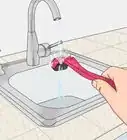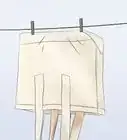This article was co-authored by wikiHow Staff. Our trained team of editors and researchers validate articles for accuracy and comprehensiveness. wikiHow's Content Management Team carefully monitors the work from our editorial staff to ensure that each article is backed by trusted research and meets our high quality standards.
There are 11 references cited in this article, which can be found at the bottom of the page.
This article has been viewed 23,594 times.
Learn more...
Light bulbs that contain even small traces of mercury are considered hazardous and require special disposal procedures. Each municipality has specific regulations for the disposal of such materials, but luckily there are a number of ways to stay in compliance. Many retailers, mail-in recycling services, local governments, and waste management facilities participate in disposing and recycling compact fluorescent lamps (CFL) and other types of lamps containing mercury.
Steps
Identifying and Removing Burnt-out Lamps
-
1Identify what type of lamps you have. Compact fluorescent lamps (CFLs), which are popular in many households, contain 4 mg of mercury on average.[1] But there are plenty of other types of lamps that contain more of the toxic chemical, including neon and black lights, fluorescents, tanning bed lamps, sodium and mercury vapor lamps, metal halide and mercury short-arc lamps.[2] You should know which type of lamp you have so you can follow the safest procedures for disposing of it.
- A printed label typically appears above a CFL’s screw base. In the U.S. these state “MERCURY DISPOSAL: EPA.GOV/CFL.” In contrast, a label on another type of lamp might read “LED LAMP” or “HALOGEN.”
- Most lamps are labeled with the manufacturer’s name and a part number, which you can research to determine what they are.
-
2Remove the lamps from their fixtures once they’re cool. Once a lamp has burned out, you should wait until it has completely cooled before attempting to remove it from its fixture. Then, unplug it (or make sure the switch is off if you’re not able to unplug it). Most household CFLs can be twisted out of their sockets, whereas fluorescent tubes can usually be rotated 90 degrees from both ends until they slide out of their sockets.
- Look up the manual for the fixture you have and follow the removal instructions.
- Consider using a ladder to safely reach the fixture, and laying down a drop cloth in case of breakage.[3]
- Arc lamps reach extremely high temperatures. You’ll risk burns and potentially ignite any surface you place one of these hot lamps upon. Wait until the lamp is cool (at least 15 minutes) before extracting it.[4]
- Neon lights can be incredibly dangerous, so don’t try to remove neon tubes from their fixtures. Enlist the help of a professional if necessary.
Advertisement -
3Package up any broken light bulbs safely, if applicable. Search for detailed cleanup procedures specific to your situation and safely follow all guidelines when cleaning up the mercury and glass shards. Use a piece of cardboard to sweep the debris into a container. Pick up mercury powder and small fragments using the adhesive side of a piece of tape and add this to the disposal container.[5] Seal it up and search specifically for a waste facility that accepts broken lamps containing mercury.
- Either a lidded plastic tub, a lidded glass container, or a resealable plastic bag is safe to use.
- Do not attempt to vacuum up the mess! Vacuum cleaning can spread toxic mercury material.[6]
- Unbroken lamps are often good candidates for recycling programs, whereas broken lamps cannot be recycled.
-
4Check local disposal regulations. Light bulbs that contain even small traces of mercury are considered hazardous household material (HHM). In many areas, they cannot be thrown in the trash and left for regular curbside pickup. Check with your local authorities to see what disposal methods are permitted and prohibited in your area.[7]
- Numerous U.S. states have banned the inclusion of light bulbs containing mercury in regular trash and landfills.
- Some municipalities do offer curbside pickup programs or semiannual HHM collections.
- If your location doesn’t require recycling and permits the inclusion of CFLs in the regular trash, you should completely seal the lamps in individual plastic bags and keep them outside in a protected space until the trash is collected.[8]
Recycling Lamps at Designated Drop-Off Locations
-
1Locate a waste collection facility, retailer, or other site for lamp disposal. Search for a participating organization near you. Many large retailers (including Home Depot, Ikea, and other stores that sell light bulbs) offer recycling programs for CFLs. Additionally, your local government or your local waste collection facility may have designated drop-off points for CFLs and other lamps.[9]
- Search online to find your local waste management facility or nearby retailers that may offer disposal services.[10]
- Some large cities even offer curbside pickup services. If yours does, you can coordinate a pickup date and time at your place of work or residence.
-
2Call the organization to collect information about their recycling process. Once you’ve targeted an organization, speak with a representative to confirm that they can indeed accept and dispose of the types of light bulbs you have. Ask about their hours of operation, drop-off location, and whether there is a fee associated with this service.
- Though some large organizations and retailers offer recycling services for light bulbs containing mercury, your local branch might not be equipped to help. This is why it’s important to call ahead and confirm.[11]
-
3Seal each lamp in an individual plastic bag. In order to prevent the light bulbs from breaking and releasing mercury into the environment during transit, you should carefully place each one in its own bag. Try using resealable plastic bags for this. The idea is to keep each light bulb in a separate bag which will contain any glass or mercury that may be released in case of breakage.[12]
-
4Pack the lamps in a sturdy, padded container for transportation. If you have a lot of light bulbs, you may want to place them gently in a container, such as a cardboard box or plastic storage tub. Pad the space between each light bulb with packing material such as crumpled paper or bubble wrap to prevent them from jostling around and breaking.[13]
- Even if you just have one or two small CFLs, you’ll still want to place them in a smaller protective container filled with packing material. Try something like a shoe box or tissue box.
- You should use even more care in packaging larger lamps. Consider using a cardboard shipping tube for protection for a fluorescent tube, for instance.[14]
-
5Turn in your old lamps at the designated drop-off point. Some retailers will have special bins in which you can place different types of hazardous materials for recycling, including light bulbs, batteries, and disposable plastic bags. Place your light bulbs carefully in the labeled container. Or, ask a representative at the organization to assist you.[15]
- Retailers’ drop-off bins usually accept unbroken, unexpired CFLs but don’t accommodate fluorescent tubes or other types of lamps. Don’t attempt to bring prohibited or broken light bulbs to these drop-off points. If broken, they could lead to significant mercury contamination at that location.[16]
- If you need to dispose of fluorescent tubes and other lamps, consider a local waste management agency instead of a retail drop-off program. Call ahead to ensure that the disposal site can accept your lamps.
Shipping Lamps to a Disposal Service
-
1Find a mail-back recycling service provider. Some manufacturers will accept return shipments of burnt-out lamps for recycling purposes, so you can look online to see if the manufacturer of your lamps offers a mail-back service. Or, select one of the many third-party organizations that facilitate mail-back recycling for mercury-filled lamps.[17]
-
2Order a recycling kit or assemble the necessary shipping materials. A recycling kit generally includes an inner packing box, a sealable liner bag, and an outer shipping box, along with packing instructions and shipping labels. You can acquire these materials yourself if your chosen service doesn’t provide kits. Make sure to acquire a Universal Waste sticker and adhere it to the outside of the package.[18]
- Even if you’re not using a kit, try to use 2 layers of sturdy cardboard boxes for added protection. Alternatively, you can use 1 box and line all of the sides with pieces of cardboard cut down to size.
-
3Package your old lamps for shipment. Use the packing materials contained if your kit, if you ordered one. Or carefully place the lamps in individually sealed plastic bags and arrange them in the inner box with some padding if necessary. Then, place this inner box within a larger box and include padding around the sides until it’s secure. Fill in the information on the Universal Waste sticker, then address the package and affix the necessary postage.
- The Universal Waste sticker should identify the contents of the package, the accumulation start date (i.e. when you packed the box, to let recipients know how much toxic material may have been released), and your name and address.
- Do not attempt to tape lamps and tubes together.[19]
-
4Mail off the lamps to the designated address. Even though the package contains hazardous waste, you can generally use any standard shipping provider to send your package off to the recycling service. If you’ve purchased a recycling kit that comes with pre-paid shipping, be sure to use the approved shipping service.[20]
- Ask your mail service provider for tracking information so you can see whether you shipment has arrived safely at the designated address.
Warnings
- If you toss a mercury-filled light bulb into the regular trash, it may break and release toxic mercury into the environment. This may also be against the law in your area.⧼thumbs_response⧽
References
- ↑ https://www.epa.gov/cfl/what-are-connections-between-mercury-and-cfls
- ↑ https://www.epa.gov/cfl/cleaning-broken-cfl
- ↑ https://www.epa.gov/cfl/cleaning-broken-cfl
- ↑ https://demolab.phys.virginia.edu/demos/documents/PASCO_Mercury_Vapor_Light_Source_OS-9286A.pdf
- ↑ https://www.epa.gov/cfl/cleaning-broken-cfl
- ↑ https://www.epa.gov/cfl/cleaning-broken-cfl
- ↑ https://earth911.com/recycling-guide/how-to-recycle-cfls/
- ↑ https://www.epa.gov/cfl/recycling-and-disposal-cfls-and-other-bulbs-contain-mercury
- ↑ https://www.epa.gov/cfl/recycling-and-disposal-cfls-and-other-bulbs-contain-mercury
- ↑ https://search.earth911.com/
- ↑ https://www.epa.gov/cfl/recycling-and-disposal-cfls-and-other-bulbs-contain-mercury
- ↑ https://earth911.com/recycling-guide/how-to-recycle-cfls/
- ↑ https://earth911.com/recycling-guide/how-to-recycle-fluorescent-tubes/
- ↑ https://earth911.com/recycling-guide/how-to-recycle-fluorescent-tubes/
- ↑ https://www.recyclingtoday.com/article/lowes-recycling-centers-cfl-batteries-phones/
- ↑ https://earth911.com/recycling-guide/how-to-recycle-cfls/
- ↑ https://www.lamprecycle.org/commercial-lighting-lamp-recyclers/
- ↑ https://sfenvironment.org/sites/default/files/fliers/files/sfe_factsheet_lights_disposal.pdf
- ↑ https://sfenvironment.org/sites/default/files/fliers/files/sfe_factsheet_lights_disposal.pdf
- ↑ https://sfenvironment.org/sites/default/files/fliers/files/sfe_factsheet_lights_disposal.pdf
- ↑ https://earth911.com/recycling-guide/how-to-recycle-cfls/
- ↑ https://earth911.com/home-garden/broken-cfl-clean-up/


